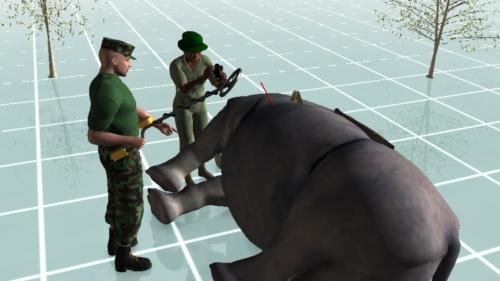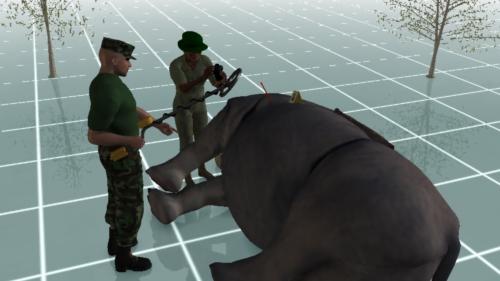Distance fog: is it useless??
 cobusp
Posts: 303
cobusp
Posts: 303
Hi all. I a doing ok with my rhino poaching animation, and thanks again to everybody who gave input to my queries.
I decided to add distance fog to add depth to my scene (which looks great, compare pic 1 with pic 3). but it does strange things, and if these cannot be solved, I'll have to dump the effect all together:
If you look at pic 2, you will notice that distance fog darkens a scene considerably. Shadows become non-existent! I thought it might be the fog density that affect these, but after changing my main light to a lower angle, brightening it to 290%, and cranking up the shadows to 100%, the shadows were still missing (see pic 3). And yes, Shadows is turned on in my render settings :-)
Is here a way around is, or should I dump everything??








Comments
It's surely because you uses the distant light only, if you add a bulb, for ex , you can see the shadows.
I don't know the answer, since I've never used the distance fog. My only guess is that it is very difficult to integrate a volume fog effect with something like shadows. When you think about it, in a fog the shadows in the real world fall on the fog particles and become diffused. Very difficult to realistically reproduce that. The shadows actually darken the fog, which is probably all swirly and volumetric and non-uniform and stuff. I'm guessing that Carrara's volume fog doesn't go into that detail.
Since you asked for a way around that, my approach would be to render a "position" pass and a shadows pass, then load those into a compositing app and plug the position pass into the app's 3D fog feature (Fusion's is very nice; you can adjust the fog parameters and see it update in real time). That way you have incredible flexibility in varying and blurring the shadows, again with updates in real time.
Hi,
Best t use a cloud instead of the fog if you want to it all in Carrara. Maybe turn off shadows for the cloud.
EDIT sorry just saw that you are animating - in that case use a cloud or:
you could also paint your own fog in ps, put it on a plane with a transmap texture and turn off shadows for the plane and then duplicate those planes going back into the distance away from the camera to gradually build up fog. You need to avoid the edges of the plane though in the renders as they will show up as artifacts
for a still...
For me I am lazy. Firstly I'd try rendering out a depth pass and dropping it into photoshop on top of your render and changing the layer parameter to 'screen', then tweaking opacity and levels etc on that depth pass layer. Depth later doesn't really work well with transmaps so you might have some hand touching up to do.
The other thing I'd do for more control is to render out an object pass or coverage pass so I could isolate different elements of your scene and then use a product like Ron's Fog brushes or his smoke brushes (or whatever you can find on the net) to paint in the fog behind the foreground elements.
A combination of those last two suggestions will give you the best most controllable results for a still.
http://www.daz3d.com/rons-fog
I come back with some tests:
It appears that the combination Distant Fog + Shadows works only with the spots and the bulbs, nothing else.
Here some scrennshots to show that when the intensity of the shadow is decreased, one needs less light.
Enable soft shadows is desirable to appear more natural.
“Hope this help”, as Andy said !
EDIT to add to push the ambiant light around 75% ?
Hmm .. that was exactly my next thought - thank you!
But instead of using a cloud, I made use of the Fog primitive in the background. I changed the ground plane to an infinite plane. This, coupled with a bit of fog in the Scene parameters, I think I came pretty close to it.
Your other idea about using trans map textures is also great! That's definitely worth remembering, thanks.
Dudu thanks - these are valuable tests you did. I'm sure they'll be useful for other people as well! I'm gonna keep them for my reference.
Only thing, of course, is that for an outdoors scene, one needs to use an infinite light (or sunlight), because the Sun's rays fall parallel with each other, whereas any artificial light source will project converging shadows.
Thanks again.
I often delete this distant light and prefer to use spots and bulbs.
To simulate the sunlight, I put my bulb (or spot) very far away of the scene, it is the only one wich cast shadows.
I made these test for me too, I wanted to know why you had this problem because I often uses a distant fog, sometimes limited to the background only (from 30m to 50 for ex., that depend of the scene and the weather).
Why ? Because in my country, it's often raining and when the sun come back, there is an atmospheric humidity.
Distant fog is good for a town or a submarine view, but if there is a lot of vegetation, the clouds are better.
Thanks Dudu. Of course, It makes sense to place a bulb light far from the scene so as to simulate sunlight.
BTW, in which countty do you live?
I live in a little country in Europa: Belgium (French side).
Hmm .. that was exactly my next thought - thank you!
But instead of using a cloud, I made use of the Fog primitive in the background. I changed the ground plane to an infinite plane. This, coupled with a bit of fog in the Scene parameters, I think I came pretty close to it.
Your other idea about using trans map textures is also great! That's definitely worth remembering, thanks.
Pleasure , nerd3d had a fog tool product here I think, worked okay but not perfect. I think he is product manager for poser now, he has been 1984 ed here ;). And does not exist....
Aah - yes. I remember purchasing such a toll form him ages ago for Poser! I guess it would work in Carrara too.
If all you need is background haze that recedes in the foreground, try rendering the Multi Pass DEPTH channel (a greyscale depth mat). In Photoshop or similar, create a copy of the Depth Channel and paste it in a layer above your render. Set mode to Lighten... and dial down the opacity.
This won't work if you have an Infinite Plane in your scene. The Depth pass is based on overall scene scale.
- Don
Thanks everybody for the comments about distance fog and shadows. I'm currently trying to use distance fog for an undersea scene where it seems to work well.
Thank you for that useful tip! I've used that function before for still images -very effective. Would it be possiblie to use that for an animation though? I do my post-production in Permiere - I assume there should be a way to extract the depth map for use in video?
Personally, as I mentioned previously, I would tend to use a "position" pass out of Carrara, and bring that into Fusion, which has an excellent volumetric fog effect. It's very quick and easy, and I think I gave a fairly detailed explanation in my compositing thread. It is quite a bit nicer than using a depth pass.
Here's an example of using that volumetric fog, along with the node graph in Fusion. The great thing is that the feedback is realtime, no need to render, and you have a ton of flexibility in modifying the fog effect. And with a position pass/volumetric fog, objects actually "exist" inside the fog since the fog effect is using actual 3D scene coordinates.
Also, the generated fog effect is shown in a separate image so you can more clearly see how it wraps around objects.
Oh, and the procedure for animations is the same as for still images, so doing animations with this method is super simple. Open Fusion, drag and drop the nodes as I've shown, connect them, select the image sequences to load (position pass sequence and image sequence) and you're done.
I use AfterEffects and Sony Vegas, but this trick works with any editor that allows video layers and modes.
Render in Carrara using MultiPass generating individual frames. I like PS files for individual frames (JPEG is lossy and create video "noise" in animations). PS files I found slightly smaller than TIF in my tests. Anyway, set the MultiPass ELement Options to generate External. This will generate individual DEPTH frames for each animation frame... which can then be read by your editor together as a video layer.
- Don